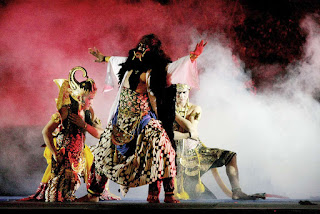Wayang Orang Sriwedari dedication to preserving traditional art
Indonesia Travel Destinations
 |
| pic. google.com |
Battle of elegance: A fight scene in the Srikandi Larasati Kembar drama episode. (JP/Ganug Nugroho Adi)
It was a special evening for members of Wayang Orang (WO) Sriwedari classical Javanese dance drama troupe, which celebrated its 107th anniversary with hundreds of spectators at Taman Sriwedari cultural park in Surakarta, Central Java, in July.
The troupe staged a collaborative show with two major groups, WO Bharata (Jakarta) and WO Ngesti Pandawa (Semarang, West Java), as well as cultural figures and dance maestros, presenting an episode of the epic Mahabharata, Srikandi Larasati Kembar (The Srikandi Larasati Twins).
The episode tells the story of King Sri Gendono and his two younger sisters, Dewi Sriweni and Dewi Sriwanti, who wish to take revenge for the death of their father at the hands of Arjuna. By disguising themselves as Srikandi and Larasti (Arjuna’s wives), the two intend to steal the weapons of Arjuna.
Instead of stealing the weapons they fall in love with Gondang Jagad and Gondang Dewo, Arjuna’s twin sons. Owing to the sincere love shown by his sisters, King Sri Gendono finally sheds his grudge against Arjuna and chooses to make peace.
Established on July 10, 1910, WO Sriwedari has incredibly survived the battering of modern times. After enjoying its heyday from 1960 to 1980, the troupe faced a decline as its stars Darsi, Rusman and Surono, slowly started to fade away.
In the 1960s, the three famous dancers were then President Sukarno’s favorites. WO Sriwedari even performed at the State Palace on a routine basis to entertain distinguished guests. Since the early 1990s its audiences have been shrinking and now only around 30 to 50 attendees watch each show at a ticket price of Rp 5,000 (37 US cents) to Rp 10,000.
 |
| pic. google.com |
The fate of the group drew the attention of the Surakarta city administration when in 2005 WO Sriwedari became the city’s asset and cultural icon through its building renovation and increased performance frequency, from three times a week to six, besides its personnel welfare promotion.
Today, 90 percent of about 85 WO Sriwedari players are civil servants. The rest include students and graduates of the Indonesian Arts Institute (ISI) of Surakarta, who have recently joined the troupe’s shows as volunteer dancers and gamelan players without pay.
Various efforts have been made to attract spectators by collaborating with artists, officials and community figures as guest stars. On such occasions, the theater can be packed to its full capacity although on regular days audience members number only in their dozens.
Sis Ismiyati, the head of the Surakarta Cultural Agency, said she has seen growing public interest in WO Sriwedari over the last few months despite its limited audience.
“At least there’s been growing enthusiasm in the society to support this traditional art form,” she said.
Maryo, 79, the most senior player, said he could well understand the small audiences in light of the mushrooming of modern forms of entertainment.
“It’s the law of nature. Every period has its own attractions to offer, but some members of the present generation are still fond of wayang orang. It’s the task of parents like us to preserve this tradition,” he said.
Maryo attributed WO Sriwedari’s survival to the troupe members’ loyalty to safeguarding the traditional drama, a struggle in which they are not alone. Other troupes such as WO Ngesti Pandawa, WO Bharata and WO Wiromo Budaya (Yogyakarta) have also experienced similar challenges. Currently, WO Sriwedari is the only group capable of performing daily from Monday through Saturday.
Members of the troupe believe they would be able to survive in the urban modern society with the support of the city administration.
Agus Prasetyo, the director of WO Sriwedari, said he hoped the city administration would help promote WO Sriwedari as a cultural icon. In the meantime, the troupe’s players should continue to explore new artistic features, story arrangements, presentation patterns and stage settings.
Agus described WO Sriwedari’s current existence as proof of the appreciation of wayang orang in various public circles.
“Artists should be more creative and the government should continue to support this cultural heritage. To date, WO Sriwedari has been a source of information on folk theater in Java. It’s too precious to lose,” he said.
SOURCE

0 komentar:
Post a Comment